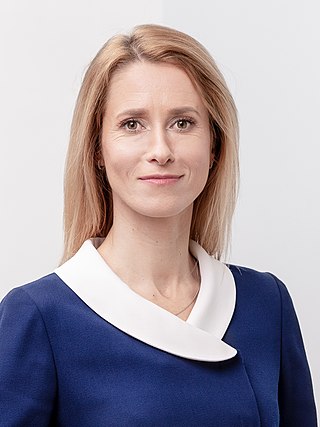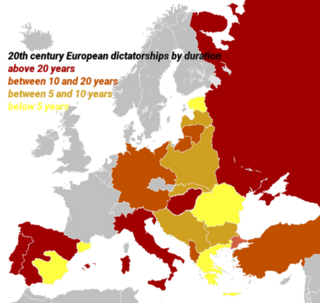
The prime minister of Estonia is the head of government of the Republic of Estonia. The prime minister is nominated by the president after appropriate consultations with the parliamentary factions and confirmed by the parliament (Riigikogu). In case of disagreement, the parliament can reject the president's nomination and choose their own candidate. In practice, since the prime minister must maintain the confidence of parliament in order to remain in office, they are usually the leader of the senior partner in the governing coalition. The current prime minister is Kaja Kallas of the Reform Party. She took the office on 26 January 2021 following the resignation of Jüri Ratas.

Konstantin Päts was an Estonian statesman and the country's president in 1938–1940. Päts was one of the most influential politicians of the independent democratic Republic of Estonia, and during the two decades prior to World War II he also served five times as the country's prime minister. After the 16–17 June 1940 Soviet invasion and occupation of Estonia, President Päts remained formally in office for over a month, until he was forced to resign, imprisoned by the new Stalinist regime, and deported to the USSR, where he died in 1956.
Parliamentary elections were held in Finland on 1 and 2 October 1930. The Social Democratic Party emerged as the largest in Parliament with 66 of the 200 seats. Voter turnout was 65.9%.
Parliamentary elections were held in Finland between 1 and 3 July 1933. The Social Democratic Party remained the largest party in Parliament with 78 of the 200 seats. However, Prime Minister Toivo Mikael Kivimäki of the National Progressive Party continued in office after the elections, supported by Pehr Evind Svinhufvud and quietly by most Agrarians and Social Democrats. They considered Kivimäki's right-wing government a lesser evil than political instability or an attempt by the radical right to gain power. Voter turnout was 62.2%.
Parliamentary elections were held in Poland on 8 September 1935, with Senate elections held a week later on 15 September. They were held under the April Constitution, drawn up earlier in 1935 by the Sanation movement, which had changed the electoral system to one more in its favor. In protest, the opposition boycotted the elections and voter turnout was only 45.9%, the lowest in the history of the Second Republic.
Parliamentary elections were held in Estonia on 24 and 25 February 1938. The National Front for the Implementation of the Constitution won 64 of the 80 seats. In turn, the Front was essentially an enlarged version of the pro-government Patriotic League.
Parliamentary elections were held in Poland on 13 October 1985. According to the Constitution of 1952 the elections should have been held every 4 years, that is in the spring of 1984, but since the internal political situation was still considered "unstable" even after the repealing in 1983 of the Martial Law, the Sejm voted to extend its own term at first indefinitely and then until August 31, 1985, fixing the elections to be held not beyond the end of 1985. As was the case in previous elections, only candidates approved by the Communist regime were permitted on the ballot. The outcome was thus not in doubt, nevertheless the regime was hoping for a high turnout, which it could then claim as evidence of strong support for the government among the population. The opposition from the Solidarity movement called for a boycott of the elections. According to official figures 78.9% of the electorate turned out to vote. This turnout, while relatively high, was much lower than the nearly 100% turnout which was reported in previous elections.

Parliamentary elections were held in Bulgaria on 27 June 1971, the first held under the new Zhivkov Constitution, which had been approved in a referendum held a month earlier. The Fatherland Front, dominated by the Bulgarian Communist Party, was the only organisation to contest the election; all candidate lists had to be approved by the Front. The Front nominated one candidate for each constituency. Of the 400 candidates 268 were members of the Communist Party, 100 were members of the Bulgarian Agrarian National Union and the remaining 32 were unaffiliated. Voter turnout was reportedly 99.9%.
National Assembly elections were held in Estonia between 12 and 14 December 1936. As the activities of all parties were suspended, only individual candidates were allowed to run. Candidates affiliated with the pro-government Patriotic League ran in all 80 constituencies, in only 30 were they contested by one or more opposition candidates. Voter turnout was 57.8%.

Parliamentary elections were held in Hungary on 8 June 1985. The Patriotic People's Front, dominated by the Communist Hungarian Socialist Workers' Party, was the only organisation allowed to contest the election. All prospective candidates had to accept the Front's program in order to be eligible.
Parliamentary elections were held in Romania on 30 November 1952. They were the second held under communist rule, and the first under a constitution adopted that September. They were also the first held after longtime Prime Minister Petru Groza handed the post to Gheorghe Gheorghiu-Dej, who as leader of the communist Romanian Workers' Party (PMR) had been the country's de facto leader since the communists seized full power in 1947.

The Farmers' Assemblies was a conservative political party in Estonia. Led by Konstantin Päts, it was one of the ruling parties during most of the interwar period.
The Settlers' Party was a political party in Estonia.
The Landlords' Party, also known as the House Owners' Party, was a political party in Estonia.
The Estonian Socialist Workers' Party was a political party in Estonia.
The Union of Settlers and Smallholders was a political party in Estonia.
The National Centre Party was a political party in Estonia.
The Left-wing Workers was a political party in Estonia.
The National Front for the Implementation of the Constitution was a 1938 electoral coalition in Estonia closely aligned with the Patriotic League.

This is a list of dictatorial regimes operational in European states in the interwar period, the period between the First World War and the Second World War.






